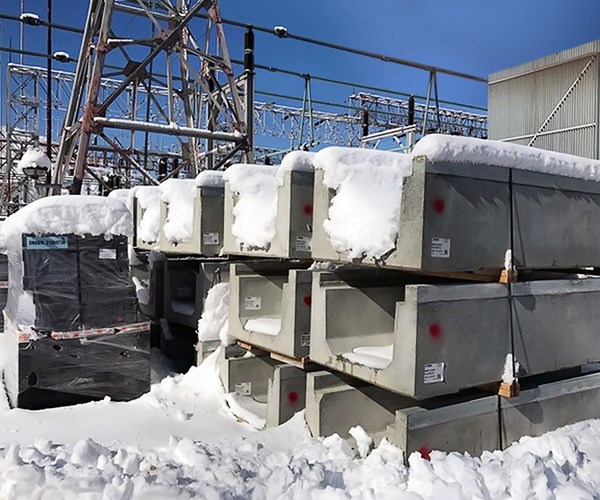An under-appreciated industrial application
A humble industrial application, manholes and trench access covers, has turned out to be a successful venture for composite manhole supplier Fibrelite.

Fibrelite’s composite trench covers fit over Trenwa’s precast concrete trenches that carry electrical cabling, at this US utility substation.
A humble industrial application, manholes and trench access covers, has turned out to be a cost-effective and successful venture for Fibrelite (Skipton, North Yorkshire, UK, an OPW Company, Hamilton, OH, US), one of several suppliers of composite manhole covers. Fibrelite, in 2014, teamed with precast concrete trench manufacturer Trenwa Inc. (Ft. Thomas, KY, US) in a strategic partnership to create a combined product offering: Trenwa’s heavy-duty precast concrete road crossing trenches topped with Fibrelite’s traffic-rated composite trench covers. Together the two products provide long-term protection for underground utilities running across road crossings while enabling safe and fast manual access for monitoring and maintenance. CW reported on the partnership in 2014: /news/fibrelite-trenwa-launch-new-composite-trench-covers. Fibrelite’s engineered composites replace metal and concrete materials, to solve manual handling and lifting injuries as well as corrosion issues associated with heave legacy covers.

Trenwa’s precast concrete trenches, over which Fibrelite’s covers fit securely.
In the three years since the partnership began, Trenwa has sold well over a hundred of their precast trench systems integrating Fibrelite trench covers, for use in electrical substations, wastewater treatment plants, chemical refineries and many other applications across North America. “Combining high-performance, lightweight Fibrelite lids with our low-cost precast trench bases delivers a very high-value solution for our customers,” says George Schurr, Trenwa’s president and COO. “They receive unparalleled strength and durability at a lower cost than has ever been seen in the market.” To meet demand, Trenwa and Fibrelite have worked to design and manufacture custom-molded composite covers to fit Trenwa’s existing line of precast multi-duty trench systems. “I am excited to see our partnership with Trenwa growing as their customer base continues to adopt our lightweight, corrosion-resistant composite trench covers,” adds Jim Goodman, Fibrelite’s key US account manager.
The advantages of the Fibrelite covers paired with precast concrete trenches were recently illustrated by a project at a new electrical substation owned by a US utility provider. Substations require the concrete trenches to contain and protect the substation’s numerous underground electric conduits and cabling, and they range from 10 – 48 inches wide, or 25 cm to 1.2m wide. Where trenches cross access roads, the trench covers must support load ratings of HS20 (i.e., a 32,000-lb or 14,545 kg axle load) to handle heavy-duty vehicles such as mobile cranes. Precast trenches are frequently preferred for their ease of installation and consistent fabrication. The problem is that the concrete or metal covers over those trenches can weigh many hundreds of pounds and are therefore difficult to remove and replace. In addition, environmental factors (rain and snow, road salts) cause metal covers to corrode and concrete covers to crack, fracture or crumble.
In contrast, the Fibrelite trench covers are extremely durable, non-electrically conductive, resistant to chemicals, not adversely affected by extreme weather or environmental conditions and unattractive to thieves looking for scrap metal. The covers are also light enough to be safely and easily removed by two operators when monitoring or maintenance of the conduits or cables in the trench is required. It’s an ergonomic yet affordable long-term solution for these omnipresent yet little-noticed parts, says Fibrelite, the maker of the first composite manhole cover. Fibrelite products are manufactured in the US, UK and Malaysia and supported by a global network of distributors: .
Related Content
The potential of rCF in fiber-reinforced concrete
A look at how emerging technologies for FRP concrete provide alternatives to traditionally used steel and glass fibers that are more cost-effective and address the sustainability challenge.
Read MoreBio-based, fire-resistant composites become mainstream
Projects use Duplicor prepreg panels with highest Euroclass B fire performance without fire retardants for reduced weight, CO2 footprint in sustainable yet affordable roofs, high-rise façades and modular housing.
Read MoreSwedish parking garage to incorporate decommissioned wind blades
Architect Jonas Lloyd is working with Vattenfall to design the multistory building with a wind blade façade, targeting eco-friendly buildings and creative ways to remove blades from landfills.
Read MoreComposite SIPs for more affordable, efficient and sustainable buildings
LiteSIP panels and modules enable framing in days, cutting structural labor and total cost by up to 70% and 30%, respectively, while increasing energy efficiency and durability.
Read MoreRead Next
Next-gen fan blades: Hybrid twin RTM, printed sensors, laser shock disassembly
MORPHO project demonstrates blade with 20% faster RTM cure cycle, uses AI-based monitoring for improved maintenance/life cycle management and proves laser shock disassembly for recycling.
Read MoreScaling up, optimizing the flax fiber composite camper
Greenlander’s Sherpa RV cab, which is largely constructed from flax fiber/bio-epoxy sandwich panels, nears commercial production readiness and next-generation scale-up.
Read MoreCutting 100 pounds, certification time for the X-59 nose cone
Swift Engineering used HyperX software to remove 100 pounds from 38-foot graphite/epoxy cored nose cone for X-59 supersonic aircraft.
Read More












